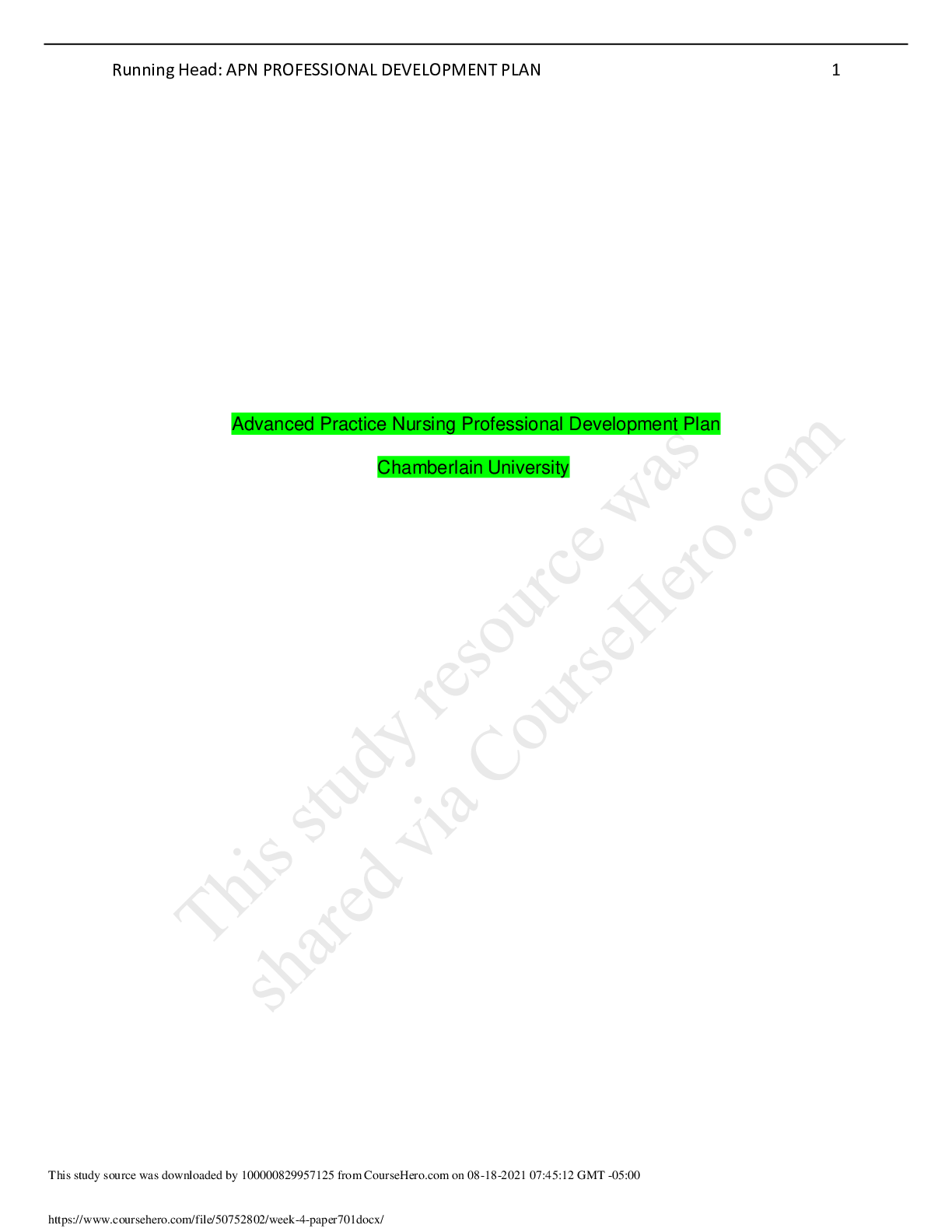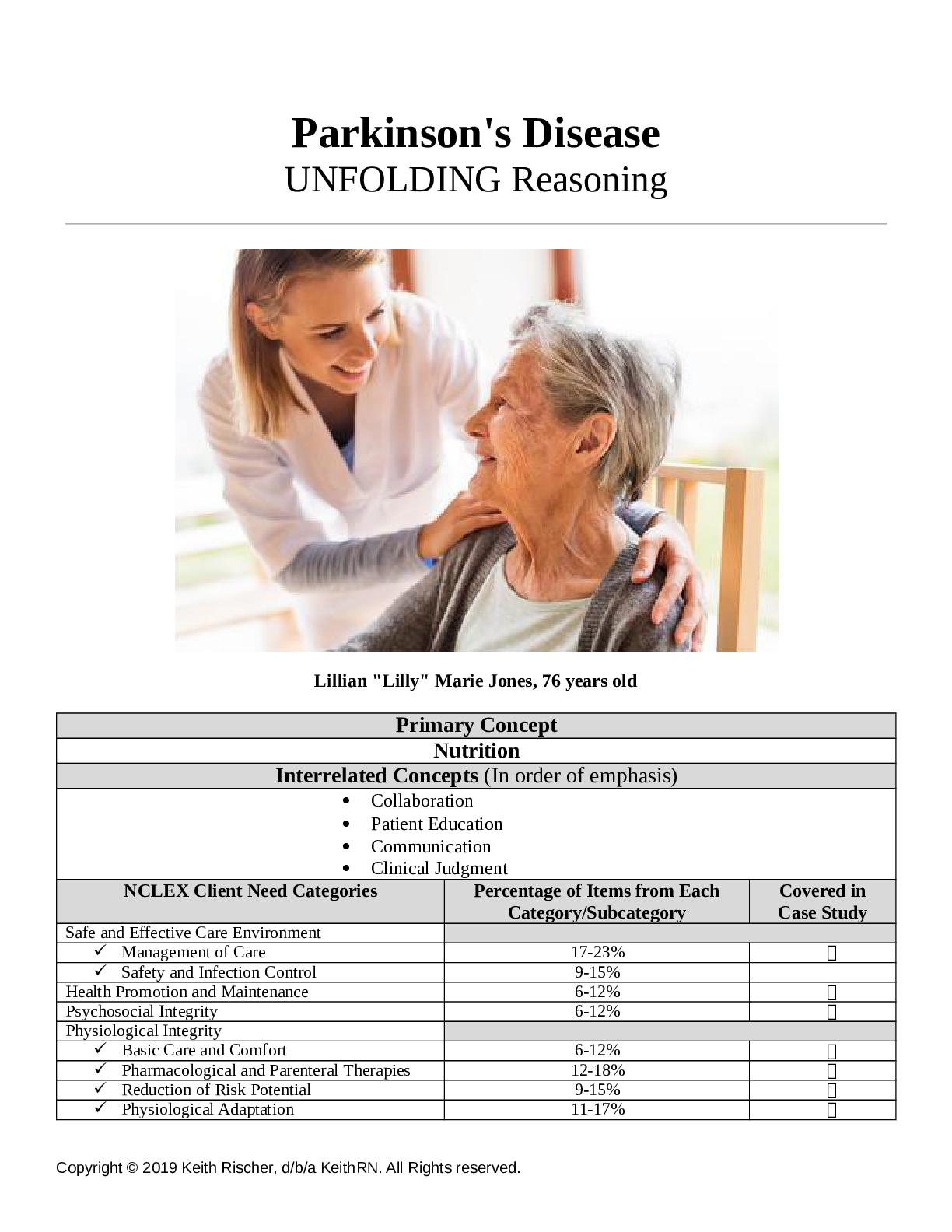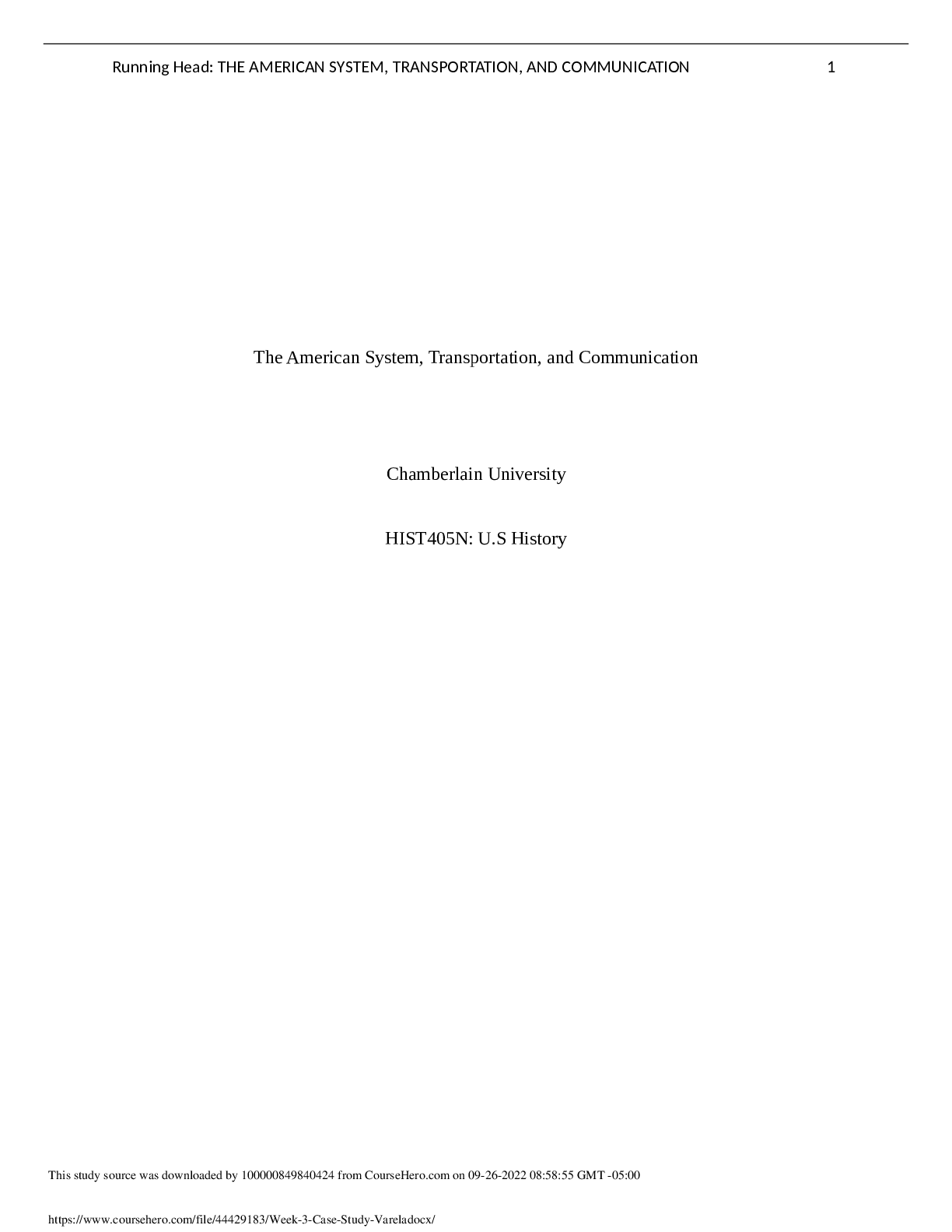*NURSING > CASE STUDY > Hayden Clark Room 305; SR Pedi Answers Updated | Download To Score A. (All)
Hayden Clark Room 305; SR Pedi Answers Updated | Download To Score A.
Document Content and Description Below
Hayden Clark Room 305 Hayden Clark, 6-year-old male, weighing 44 lbs., comes to school looking disheveled, and not wearing a coat with the outside temperature in the low 40’s. You responded corr... ectly to 6 out of 6 evaluations: Category Your response Explanation Educational Needs Increased acuity Education needed for child and parents relating to clothing, hygiene, and physiological needs. Health Increased acuity Status assessment reports patient not wearing coat in 40-degree weather. LOC Normal acuity Status assessment reports no indication of increased LOC acuity Pain Normal acuity Status assessment reports no indication of increased Pain acuity Psych Normal acuity Status assessment reports does not give clear indication to increased Psych acuity Safety Increased acuity Status assessment reports not wearing coat which places patient at risk for hypothermia Hannah Johnson Room 304 Hannah Johnson, 10-year-old female presented to the ED 45 minutes ago with dehydration, dysuria, and significant weight loss of 18 pounds over the last 2 months. Both parents are with the child, the father is insisting that he be notified of all interventions before they are initiated. Initial assessment reveals: Skin dry and warm to touch, B/P 90/58, T 99.2 F, 37.3 C, HR 110, RR 30. Child appears thin. Breathing is fast and deep. Noted fruity odor to breath. Initial labs: CBC WNL, K+ 2.89, BG 459, Urinalysis: Positive for ketones, glucose, and bacteria. Orders: IV 0.9% normal Saline at 150 ml/hour, Add 20 mEq K+ after first liter, Ampicillin 250 mg PO q 6 hours, finger stick blood glucose (FSBG) q 1 hour. You responded correctly to 4 out of 6 evaluations: Category Your response Explanation Educational Needs Increased acuity Status assessment reports abnormal and possible newly diagnosis of type 1 diabetes. Health Increased acuity Status assessment reports abnormal labs and weight loss. LOC Normal acuity Status assessment reports no indication of increased LOC Pain Increased acuity Status assessment reports dysuria. Psych Normal acuity Status assessment reports no indication of Psychiatric deficits Safety Increased acuity Status assessment reports IV's and High Blood Glucose. Amanda Blaire Room 301 Amanda Blaire, 14-year-old female, who was in an ATV accident and now has a fractured tibia and fibula. Her vital signs are Temperature 98.6 F, 37.0 C, HR 87, BP 111/72, RR 18, PaO2 97%. She is post-op day 1 with continuous traction and skeletal pins to immobilize leg. Category Your response Explanation Educational Needs Increased acuity Status Assessment reports fracture and surgery and rehabilitation needs Health Increased acuity Status Assessment reports fractures, major surgery, and rehabilitation n LOC Normal acuity Status assessment reports no indication of increased LOC acuity Pain Increased acuity Status Assessment reports fractures, major surgery, and rehabilitation n Psych Normal acuity Status assessment reports no indication of increased Psychiatric acuity Safety Increased acuity Status Assessment reports fractures, major surgery, and rehabilitation n Baby Harris Room 302 Baby Harris, 4-hour-old newborn male, weight 6.6 lbs. with a length of 18” and approximate gestational age of 36 weeks. Late prenatal care. Mom has history of methamphetamine and heroin addiction. In addition, the mom admits to smoking 1 pack per day through pregnancy. Urine drug test on baby positive for heroin and methamphetamine. VS: T 98.1 F, 36.7 C, HR 178, R 70, PaO2 96%. Category Your response Explanation Educational Needs Increased acuity Mother needs to be taught to recognize signs of drug withdrawal. Health Increased acuity All body systems are affected by drug withdrawal. LOC Increased acuity Status assessment reports baby tested positive for drugs which affect L Pain Increased acuity Drug withdrawal increases irritability and pain. Psych Increased acuity Drug withdrawal affects levels of well-being. Safety Increased acuity Increased probability of seizures. Paul Windsor Room 303 Paul Windsor, 4-year-old male admitted yesterday from the clinic with a diagnosis of Nephrotic Syndrome. Vital signs: Temperature 99.0 F, 37.2 C, HR 88, BP 104/76, RR 22, PaO2 95%. He presented yesterday with his parents reporting a gradual increase in pain and “swelling” around his eyes and ankles, and now his stomach is getting “bigger". Paul has little to no appetite. Current weight is 56 pounds compared to a usual weight of 43 pounds. Urinalysis: Thick, frothy appearance. Specific gravity: 1.025. Protein 3+. Blood 2+. Other labs: Triglycerides 180 mg/dl. Cholesterol 190 mg/dl. Group B strep culture negative in office. Category Your response Explanation Educational Needs Increased acuity Mother and patient need renal diet and fluid restriction education. Health Increased acuity Status assessment reports weight gain and recent abnormal labs. LOC Normal acuity Status assessment reports no indication of increased LOC acuity Pain Increased acuity Status assessment reports gradual increase pain and “swelling” around his ey Psych Normal acuity Status assessment reports no indication of increased Psychiatric acuity Safety Increased acuity Status assessment reports pain around ankle making patient a fall risk. Paula Smith Room 304 Paula Smith, 16-year-old female. She is a dancer who presents to the clinic for a yearly physical, and is found to have significant weight loss, loss of menstrual cycles, and depression. She is 5’7” and weighs 94 pounds. Educational Needs Increased acuity Patient needs to recognize seriousness of significant weight loss Health Increased acuity Status assessment reports significant weight loss, loss of menstrual cycles, an LOC Normal acuity Status assessment reports no indication of increased LOC acuity Pain Normal acuity Status assessment reports no indication of increased Pain acuity Psych Increased acuity Status assessment reports depression Safety Increased acuity Status assessment reports depression Baby Strickland Room 305 Category Your response Explana Educational Needs Increased acuity Status assessment reports uncontrolled diabetes. Health Increased acuity Status assessment reports mother is dx with diabetes and patien LOC Normal acuity Status assessment reports no indication of abnormal LOC Pain Normal acuity Status assessment reports no indication of Pain Psych Normal acuity Status assessment reports no indication of Psychiatric deficits Safety Increased acuity Status assessment reports baby large for birth and at risk for vol Baby Strickland, 1-hour-old newborn female, 37-week gestational age born via C-section, weight 9.9 lbs. Mom has history of diabetes, not well controlled. Maria Hernandez Room 306 Maria Hernandez, 6-year-old female, weighing 39.6 lbs. with a history of Sickle Cell Disease. She has presented to the ED in sickle cell crisis and has a history of UTIs. Vital signs: Temp 101.8 F, 38.8 C, B/P 131/79, HR 108, PaO2 87% room air, RR 51. Category Your response Explanation Educational Needs Increased acuity Status assessment reports patient needs to know to prevention steps (i.e. good hydr Health Increased acuity Status assessment reports patient in sickle cell crisis. LOC Normal acuity Status assessment reports no indication of increased LOC acuity Pain Increased acuity Status assessment reports patient in sickle cell crisis which is painful. Psych Normal acuity Status assessment reports no indication of increased psychiatric acuity Safety Increased acuity During sickle cell crisis patient is a fall risk Mark Quinn Room 307 Category Your response Expl Educational Needs Increased acuity Status Assessment reports impending surgery and rehabil Health Increased acuity Status assessment reports abdominal pain, normoactive b LOC Normal acuity Status assessment reports no indication of increased LOC Pain Increased acuity Status assessment reports abdominal pain, normoactive b Psych Normal acuity Status assessment reports no indication of increased Psyc Safety Increased acuity Status assessment reports abdominal pain and nausea ca Mark Quinn, 9-year-old male comes to the school nurse with complaints of abdominal pain and nausea. Vital signs: Temperature 98.2 F, 36.8 C, HR 87, BP 104/ 67, RR 22, PaO2 97%. The nursing assessment reveals diffuse lower abdominal pain, tenderness, and normoactive bowel sounds. After consultation with the child and the parents, the child is sent home with a possible viral intestinal infection. Jonathan Gibbons Room 308 Category Your response Explanatio Educational Needs Increased acuity Status assessment reports patient waited longer than expected. Needs Health Increased acuity Status assessment reports patient with bad cough and abnormal vital s LOC Normal acuity Status assessment reports no indication of increased LOC acuity. Category Your response Explanatio Pain Increased acuity Status assessment reports patient is in tenting position and using acce Psych Normal acuity Status assessment reports no indication of increased Psychiatric acuity. Safety Increased acuity Status assessment reports patient has IV therefore making him a fall ris Jonathan Gibbons, 13-year-old male diagnosed with asthma since he was 3 years old. He uses a rescue albuterol inhaler (PRN) on an "as needed" basis. Jonathan presents to the clinic with what his mother calls a “bad cold and cough” that has been present for 3 days. Vital signs and assessment: B/P 110/65 T100.8 F, 38.2 C, HR 110 RR 26, PaO2 92%. Bilateral wheezing can be heard throughout all lung fields. Jonathan is seen in a tenting position and using accessory muscles to breathe. He has been using his rescue albuterol inhaler q 2 hours for the last 6 hours with minimal relief. Orders: Admit to the pediatric unit at Children’s hospital, IV methylprednisolone 40mg q day, Ampicillin 250 mg IV q 6 hours, Tylenol 500 mg PO q 6 hours prn Temp/Pain, Xopenex 0.63 mg q 6 hours per nebulizer and PRN. Assign nursing concerns: Hannah Johnson 10-year-old female presented to the ED 45 minutes ago with dehydration, dysuria, and significant weight loss of 18 pounds over the last 2 months. Both parents are with the child, the father is insisting that he be notified of all interventions before they are initiated. Initial assessment reveals: Skin dry and warm to touch, B/P 90/58, T 99.2 F, 37.3 C, HR 110, RR 30. Child appears thin. Breathing is fast and deep. Noted fruity odor to breath. Initial labs: CBC WNL, K+ 2.89, BG 459, Urinalysis: Positive for ketones, glucose, and bacteria. Orders: IV 0.9% normal Saline at 150 ml/hour, Add 20 mEq K+ after first liter, Ampicillin 250 mg PO q 6 hours, finger stick blood glucose (FSBG) q 1 hour. You correctly diagnosed 8 out of 8 options: Physiological Description Breathing pattern, ineffective Your Respons e Explanation True Status assessment reports altered breathing pattern Dehydration True Status assessment reports medical dx of dehydration related to abnormal labs and weight loss. Tissue integrity, impaired Safety False Status assessment reports no indication of Tissue integrity, impaired Your Description Response Explanation Anxiety False Status assessment reports no indication of Anxiety. Patient would be "at Risk for" Infection True Status assessment reports dysuria with presence of bacteria in urine Knowledge deficit True Status assessment reports new medical diagnoses and weight loss Risk for True Status assessment reports IV's and Your Description Response Explanation injury High Blood Glucose. Esteem Description Growth and development Your Response Explanation True Need for adolescence education for new diagnosis. Baby Harris 4-hour-old newborn male, weight 6.6 lbs. with a length of 18” and approximate gestational age of 36 weeks. Late prenatal care. Mom has history of methamphetamine and heroin addiction. In addition, the mom admits to smoking 1 pack per day through pregnancy. Urine drug test on baby positive for heroin and methamphetamine. VS: T 98.1 F, 36.7 C, HR 178, R 70, PaO2 96%. Your Description Response Explanat Activity Intolerance True Patient is at Risk for Activity Intolerance Cardiac/Perfusion, Decreased False Status assessment reports no indication o Fluid volume, altered excess False Status assessment reports no indication o Imbalanced nutrition, less than body True Effects of withdrawal include vomiting and requirements Impaired gas exchange False Patient would be at risk for Impaired gas e breathing. Risk for altered thermoregulation True The compensatory mechanism of body te opiates. Risk for blood glucose instability True Major body systems affected by withdraw Baby Strickland 1-hour-old newborn female, 37-week gestational age born via C-section, weight 9.9 lbs. Mom has history of diabetes, not well controlled. Description Your Response Explanation Hypoglycemia, Risk for True Status assessment reports mother is dx with diabet lbs. 13 oz. Impaired Gas Exchange True Patient is at risk for Impaired Gas Exchange if patie Impaired skin integrity False Status assessment reports no indication of impaired Ineffective breathing pattern, Risk True Status assessment reports patient is 1 hour old and for Thermoregulation, Risk for True Status assessment reports patient is 1 hour old. Jonathan Gibbons 13-year-old male diagnosed with asthma since he was 3 years old. He uses a rescue albuterol inhaler (PRN) on an "as needed" basis. Jonathan presents to the clinic with what his mother calls a “bad cold and cough” that has been present for 3 days. Vital signs and assessment: B/P 110/65 T100.8 F, 38.2 C, HR 110 RR 26, PaO2 92%. Bilateral wheezing can be heard throughout all lung fields. Jonathan is seen in a tenting position and using accessory muscles to breathe. He has been using his rescue albuterol inhaler q 2 hours for the last 6 hours with minimal relief. Orders: Admit to the pediatric unit at Children’s hospital, IV methylprednisolone 40mg q day, Ampicillin 250 mg IV q 6 hours, Tylenol 500 mg PO q 6 hours prn Temp/Pain, Xopenex 0.63 mg q 6 hours per nebulizer and PRN. Physiological Description Communication, impaired for verbal Your Response Explanation False Status assessment reports no indication of Communication, i Impaired gas exchange True Status assessment reports patient is in tenting position and u with abnormal lab signs. Pain, at risk Acute True Status assessment reports tenting position and using accesso pain Respiratory distress True Status Assessment reports patient bilateral wheezing through tenting position using accessory muscles to breathe. Safety Description Your Response Explanation Anxiety True Patient is at risk for Anxiety. Knowledge True Status assessment reports patient waited 3 day to seek medical attenti Description Your Response Explanation deficit treatment elapse time. Maria Hernandez 6-year-old female, weighing 39.6 lbs. with a history of Sickle Cell Disease. She has presented to the ED in sickle cell crisis and has a history of UTIs. Vital signs: Temp 101.8 F, 38.8 C, B/P 131/79, HR 108, PaO2 87% room air, RR 51. Description Your Response Acute Pain True Patients in sickle cell crisis ex Altered skin integrity False Patient is at risk for altered sk Impaired gas exchange True Status assessment reports Pa Risk for delayed development True Due to chronic illness and pos Physiological Safety Description Your Response Explanation Anxiety, Risk for True Patient is at risk for anxiety related to Sickle Cell Infection, high risk for sepsis False Status assessment reports no indication of Infect Mark Quinn 9-year-old male comes to the school nurse with complaints of abdominal pain and nausea. Vital signs: Temperature 98.2 F, 36.8 C, HR 87, BP 104/ 67, RR 22, PaO2 97%. The nursing assessment reveals diffuse lower abdominal pain, tenderness, and normoactive bowel sounds. After consultation with the child and the parents, the child is sent home with a possible viral intestinal infection. Physiological Description Your Response Explanatio Acute Pain True Status assessment reports abdominal pain. Fluid volume deficit True Patient is at risk for Fluid volume deficit. Description Your Response Explanatio Impaired skin integrity False Patient is at risk for Infection. Oral, mucous membranes, altered False Status assessment reports no indication of oral Safety Description Your Response Explanation Deficient Knowledge False Status assessment reports nothing definitive to point to Risk for infection True Patient is experiencing signs of Appendicitis. Paul Windsor 4-year-old male admitted yesterday from the clinic with a diagnosis of Nephrotic Syndrome. Vital signs: Temperature 99.0 F, 37.2 C, HR 88, BP 104/76, RR 22, PaO2 95%. He presented yesterday with his parents reporting a gradual increase in pain and “swelling” around his eyes and ankles, and now his stomach is getting “bigger". Paul has little to no appetite. Current weight is 56 pounds compared to a usual weight of 43 pounds. Urinalysis: Thick, frothy appearance. Specific gravity: 1.025. Protein 3+. Blood 2+. Other labs: Triglycerides 180 mg/dl. Cholesterol 190 mg/dl. Group B strep culture negative in office. Physiological Description Your Response Explanatio Fluid volume deficit True Patient is at risk for Fluid volume deficit. Impaired skin integrity True Status assessment reports would be at risk for Risk for Thrombus formation True Status assessment reports high triglycerides an Safety Description Your Response Explanation Deficient Knowledge True Status assessment reports new diagnosis of Nephro Infection True Patient is at risk for Infection Paula Smith 16-year-old female. She is a dancer who presents to the clinic for a yearly physical, and is found to have significant weight loss, loss of menstrual cycles, and depression. She is 5’7” and weighs 94 pounds. Physiological Your Description Response Explan Alteration in nutrition, less than body True Status assessment reports significant requirements Fluid volume deficit True Patient is at risk for Fluid volume defi Ineffective health management True Status assessment reports significant Swallowing impaired, high risk for False Status assessment reports no indicat risk for Esteem Description Your Response Expl Impaired self esteem True Status assessment reports depre Ineffective coping True Status assessment reports depre Amanda Blaire 14-year-old female, who was in an ATV accident and now has a fractured tibia and fibula. Her vital signs are Temperature 98.6 F, 37.0 C, HR 87, BP 111/72, RR 18, PaO2 97%. She is post-op day 1 with continuous traction and skeletal pins to immobilize leg. Physiological Description Your Response Explanat Acute pain True Status assessment reports fractured tib/fib skeletal pins. Constipation False Patient is at risk for Constipation. Impaired mobility True Status assessment reports fractured leg an immobilized leg. Impaired skin integrity True Status assessment reports is post op with s Nutrition, altered less than body requirements False Status assessment reports no indication of requirements Risk for infection True Status assessment reports Post op. Tissue Perfusion, altered False Status assessment reports no indication of Safety Descrip tion Your Response Infection False Knowled ge deficit True Suzanne Williams 5-year-old female, weight 35.2 lbs., recently diagnosed with leukemia. CBC results: neutroph count 30,000. She is reporting gradual arm and leg pain at a 6/10 over the last 4 weeks. Par “growing pains”. Patient experiencing n/v/d and loss of appetite. Vital Signs Temperature 10 100/65, RR 23, PaO2 95%. The patient is beginning a second round of chemotherapy. You correctly diagnosed 6 out of 6 options: Physiological Description Your Respons e Explanation Fluid volume deficit True Status assessment reports patient experiencing n/v/d and loss of appetite. Imbalanced nutrition, less than body requirements True Status assessment reports patient experiencing n/v/d and loss of appetite. Risk for infection False Elevated white blood count indicate infection already present Urinary Retention False Status assessment reports no indication of Urinary Retention. Love and Belonging Description Grieving, at risk for Interrupted family processes Your Response Explanation True Status assessment reports diagnosis of leukemia. False Patient has been diagnosed with leukemia which places family at risk for Patient care scenarios: 1Attempt to obtain a maternal history of prenatal drug exposure. Initial assessment to understand 1 2Perform hair and urine testing. Confirmation of initial subjective 2 3Consider opioids as first line of treatment Babies with opioid addiction sho 4 sudden stop (birth of baby) 4Consider Phenobarbital as second line of effective treatment Effective treatment to prevent s 5 5Obtain order for blood screening sexually transmitted diseases. Blood screening is for HIV, Hepa 3 Discussion about breast feeding should be considered. Gonorrhea and breast feeding to Baby Harris Scenario 1 You are concerned about this baby four hours after birth because he is now exhibiting exces has a high-pitched cry. To confirm your suspicion that he is a drug addicted baby, your treat Your order Correct order Step Your order Correct order Step 1 1 Place baby under radiant warmer Temperature is low and can 2 2 assess BG via heel stick. BG is 34 Assessment needed based 4 3 Notify lab for confirmation BG level Protocol is to obtain lab con 5 4 OG feed baby 10 ml formula Intervention needed to prev 3 5 Reassess BG level in 15 minutes Assess if intervention was e Your order Correct order Step Your order Correct order Step Fill these drugs of this patient's 24-hr MAR by choosing the “Select” button. If the medication can't b dosing parameters, select “Error”. . Simulation of narcotics loaded in the med cart for a 24 hour peri demonstrate medication calculation (not necessarily a health care institution protocol). 1 bag D5 0.25 NS (D5 0.25 NS ) 4 morphine-oral sol (morphine) 1 phenobarbital IV (Phenobarbital ) Times: morphine-oral sol (morphine) -- 0.5 each time D5 0.25 NS (D5 0.25 NS ) 6 phenobarbital IV (Phenobarbital ) 4.5 Baby Strickland Scenario 1 Assessment: baby appears jittery, temp 97.2 under warmer, RR 62, HR 160 Your order Correct order Step 2 1 Obtain heel stick blood glucose level – assess BG based on baby sy level is 35 Your order Correct order Step 1 2 Feed baby ½ ounce formula correct intervention for hyp 3 3 Notify lab for confirmation blood glucose level - value is 29 Protocol is to get confirmati intervention for safety conc 5 4 Recheck blood glucose in 45 minutes, value is 45 reassess to see if interventi 4 5 Continue to monitor baby may have future episo monitored Your order Correct order Step Ex 3 1 Momentarily place baby in Lowering to Trendelenburg for a few m Trendelenburg while facilitating the Then return to positioning the baby wit drainage may cause Cerebral Edema. 5 2 Suction excessive secretions via bulb syringe and NG tube Removes excess secretions 2 3 Place under oxy hood at 40% Need to achieve O2 sat > 90% 1 4 Initiate IV D5 ¼ NS at 6 ml/hour Fluids to keep baby hydrated, access f 4 5 Reassess respiratory system To see if interventions have been effec Your order Correct order Step 3 1 Assess vital signs – Temp 97.2, RR 66, HR 160 Assessment dete information 1 2 Wrap baby in warm blanket and put hat on baby’s head Quickest way to heat loss 4 3 Reassess temperature in 15 minutes, Still 97.4 Determines if int 2 4 Place baby in radiant warmer with temperature probe attached Further intervent safety 5 5 Educate parents on neonatal heat loss and how to prevent this Prevent further p Your order Correct order Step 1 1 Place infant in isolation radiant warmer Isolation to prote 5 2 Obtain ordered blood cultures blood cultures ne 3 3 Initiate IV Ampicillin per MD order Initiate IV Ampici the infection Your order Correct order Step 3 1 Assess vital signs – Temp 97.2, RR 66, HR 160 Assessment dete information 4 4 Reassess Blood glucose BG = 38 BG levels fall in t 2 5 OG feed infant 15 ml Infant Formula baby needs nutri Your order Correct order Step 1 1 Place infant in triple phototherapy isolette 2 2 Place protective eye shields over the baby’s eyes phototherapy is needed to prev safety to protect the infant’s ey 3 3 Initiate the phototherapy treatment needed to decrease bilirubin lev 4 4 Feed infant every 2 ½ hours infants under bilirubin lights ne bowel movements. 5 5 Document number of voids and stools more frequent feedings will resu per shift how bilirubin is excreted Fill these drugs of this patient's 24-hr MAR by choosing the “Select” button. If the medication can't b dosing parameters, select “Error”. . Simulation of narcotics loaded in the med cart for a 24 hour peri demonstrate medication calculation (not necessarily a health care institution protocol). D5 0.25 NS (D5 0.25 NS ) 1 bag ampicillin IV (Ampicillin) 1 bag Times: D5 0.25 NS (D5 0.25 NS ) 7 ampicillin IV (Ampicillin) 5 Jonathan Gibbons Scenario 1 Jonathan states that he is having increased difficulty breathing over the last 20 minutes. Your order Correct order Step order order Step 1 1 Ask the grandparents if they smoke, and if Assessment of home si they do if they smoke in the house or around Jonathan 3 2 Educate the grandparents on the dangers of second-hand smoke that can exacerbate Jonathan’s asthma. Education provided as relationship of second- 2 3 Educate Jonathan and his parents of the Provides information to dangers of being around second-hand smoke. prevention for asthma. 5 4 Talk with Jonathan about other triggers Assessment of other po that he is aware of for his asthma 4 5 Educate Jonathan about triggers that he might not be aware of Assists the child to avo Your order Correct order Step 1 1 Assess breath sounds, notes inspiratory wheezing As 2 2 Administer MDI albuterol inhaler 2 puffs (kept in school nurse office) Int ex 3 3 Reassess lung sounds. Inspiratory and expiratory wheezes now present. Jonathan is showing increased signs of anxiety. 4 4 Administer 2nd dose of MDI albuterol inhaler (2 puffs). Have Jonathan to loosen clothing and assume a tent position. Wheezing worsening 5 5 No improvement in vital signs. Notify MD and 911 for transport to Re to Int eff Int hospital. fur Your order Correct order Step Fill these drugs of this patient's 24-hr MAR by choosing the “Select” button. If the medication can't b dosing parameters, select “Error”. . Simulation of narcotics loaded in the med cart for a 24 hour peri demonstrate medication calculation (not necessarily a health care institution protocol). acetaminophen (Tylenol) 4 ampicillin IV (Ampicillin) 4 methylprednisolone IV (SoluMedrol) 1 Times: acetaminophen (Tylenol) 1 ampicillin IV (Ampicillin) 133 methylprednisolone IV (SoluMedrol) 100 Maria Hernandez Scenario 1 Assessment reveals: left knee swollen, red, and tender to touch. Pain is rated 9/10. Tempera 130/74, HR 110 pulse oximeter is 86% on room air. Maria is crying, unable to be consoled. H Your order Correct order Step 1 1 Start O2 per face mask at 4 L/min Sickle cell crisis occurs and limits and increased pain 5 2 Obtain urine specimen for urinalysis Should be taken prior to trauma o and culture and sensitivity 2 3 Start IV and draw CBC, BMP This avoids multiple sticks (relate baseline lab work to determine ot 4 4 Initiate IV fluids d5 ½ NS at 75 ml/hour IV hydration is needed to prevent 3 5 Administer Morphine Sulfate 4 mg/IV per MD order Relieve intense pain of sickle cell Your order Correct order Step 4 1 Ask the mother what she knows about sickle cell crisis and triggers for this disorder 2 2 Assess the child’s nutritional status through a 24- hour diet recall (child prefers chicken nuggets, French fries, and soft drinks for lunch) 1 3 Ask the child what she most likes to drink 5 4 Provide additional information on nutrition, hydration, prevention of illness t the mother 3 5 Based on education, provide the child with healthy options for fluid intake Your order Correct order Step Your order Correct order Step Fill these drugs of this patient's 24-hr MAR by choosing the “Select” button. If the medication can't b dosing parameters, select “Error”. . Simulation of narcotics loaded in the med cart for a 24 hour peri demonstrate medication calculation (not necessarily a health care institution protocol). acetaminophen (Tylenol) 4 D5 0.45 NS (D5 0.45 NS ) 2 diphenhydramine (Benadryl 1 morphine-IV (morphine 4 trimethoprim-oral sol (Bactrim) 5 Times: HOLD PRN IF NOT NEEDED each time!!!! acetaminophen (Tylenol) give 1 for temp D5 0.45 NS (D5 0.45 NS ) 75 diphenhydramine (Benadryl 1 morphine-IV (morphine--- 1 hold when not needed trimethoprim-oral sol (Bactrim) 5 Mark Quinn Scenario 1 Mark, 9 years old, presents to the ED with abdominal cramps, nausea, vomiting x 2 days wit F. HR 98 RR 24 B/P 120/74 O2 sat 98% in room air. Your order Correct order Step 1 1 Physical exam of abdomen – rebound tenderness in right assessmen lower quadrant 4 2 Lab work – CBC, BMP, urinalysis. WBC 18,000, Neutrophils elevated needed to 5 3 Initiate IV fluids LR at 100 ml/hour IV fluids to IV medicat 2 4 Administer promethazine 12.5 mg IV for nausea treat symp 3 5 Consult for surgery suspected Your order Correct order Step 4 1 Turn off suction turn off s 3 2 Assess bowel sounds – minimal to absent in all 4 need fur quadrants symptom Your order Correct order Step 2 3 Assess proper placement and patency of NG tube ensure p 5 4 Turn on suction needed t 1 5 Notify Physician of continuing nausea and absent bowel abnorma sounds consult Your Correct Your order Correct order Step Your order Correct order Step 3 1 Report any signs of infection such as redness, these are signs o increased drainage, fever addressed should 5 2 Teach Mark and parents about no lifting, straining, need to let incisio jumping, or running 4 3 Teach Mark and parents soft diet with limited fiber needed to let GI t Your order Correct order Step for 2 weeks 1 4 Take stool softener nightly for next week prevent constipa 2 5 Provide follow up doctor appointment and time follow up with his needed Fill these drugs of this patient's 24-hr MAR by choosing the “Select” button. If the medication can't b dosing parameters, select “Error”. . Simulation of narcotics loaded in the med cart for a 24 hour peri demonstrate medication calculation (not necessarily a health care institution protocol). D5 0.25 NS (D5 0.25 NS )--- 3 promethazine Inj (Phenergan) 1 Times: D5 0.25 NS (D5 0.25 NS ) 100 promethazine Inj (Phenergan) 1 Paul Windsor Scenario 1 CBC from last night shows the following: Hgb -18g/dl, and Hct 43%. Paul’s skin is dry to touc Your order Correct order Step Your order Correct order Step 5 1 Tell Paul it is time for his medication Age approp 3 2 Check order and prepare PO medications Safety for m 4 3 Give Paul the choice of taking his medication with apple juice Addresses c or milk some contro Your order Correct order Step 5 1 Tell Paul it is time for his medication Age approp 1 4 Administer PO medications Give medica 2 5 Reassure Paul that he did well Positive rein cooperation Your order Correct order Step 2 1 Assess knowledge level of parents Always asse education is 5 2 Explain the pathophysiology of nephrotic syndrome to When paren parents using layman’s terms better unde 3 3 Discuss treatment plan of steroids and fluid restriction with Discuss plan parents parent unde 1 4 Provide Paul with age appropriate coloring book to learn care Allows child about being in the hospital learning too 4 5 Have the parents and Paul demonstrate the information Evaluates te about being in hospital and the diagnosis of nephrotic syndrome. Your order Correct order Step 4 1 Ask Paul about his food preferences Always as 1 2 Show Paul a picture menu that he can point out the foods that Age appro he likes and does not like appropriat 5 3 Educate parents that Paul needs to reduce sodium, avoid fatty This diet i foods (including eggs & dairy) and fried food need to be 3 4 Provide Paul with a low sodium age appropriate lunch Meet nutri 2 5 Document teaching and evaluation for Paul and parents Evaluation related to diet Your order Correct order Step 3 1 Weigh patient again after verifying scale Verifying accuracy of e calibration abnormal values 5 2 Assess vital signs and compare to previous Vital signs may indicat vital signs weight gain Your order Correct order Step 6 3 Assess skin, face, and dependent areas Edema often occurs in 1 4 Assess intake and output Needs to be compared 2 5 Administer Lasix as ordered Intervention based on 4 6 Reassess vital signs Reassessment to see i Fill these drugs of this patient's 24-hr MAR by choosing the “Select” button. If the medication can't b dosing parameters, select “Error”. . Simulation of narcotics loaded in the med cart for a 24 hour peri demonstrate medication calculation (not necessarily a health care institution protocol). D5 0.45 NS (D5 0.45 NS 1 prednisone (Deltasone) 1 Times: D5 0.45 NS (D5 0.45 NS 75 prednisone (Deltasone) 1 Paula Smith Scenario 1 Establish trust and a baseline physical assessment. Your order Correct order Step 4 1 Introduce self, ask Paula to tell you about herself, including Establishes self-esteem and body image relationship 5 2 Perform a basic physical assessment and document Provides fur findings 3 3 Ask Paula to write down a 24-hour food recall, and exercise routine Needed for 1 4 Talk with Paula about the findings and the need for Paula has th counseling and nutritional support plan of care 2 5 Refer Paula to a nutritionist and psychiatrist Anorexia Ne multidiscipli Your order Correct order Step 2 1 Perform a baseline physical assessment including weight, Neede Your order Correct order Step height, and BMI 1 2 Inform Paula that all meals and snacks will be supervised Explain 5 3 Talk with Paula about the need for continuous supervision for 30 minutes after each meal. Neede ensure 3 4 Talk with Paula about the routine of the unit, and the schedule Introdu for meals that wi 4 5 Document findings and teaching in Paula’s chart Legal r progre Your order Correct order Step Your order Correct order Step 1 1 Ask Paula why she felt the need to exercise in her Assess her motiv room unsupervised Anorexia Nervos 2 2 Talk with Paula about the need for supervised Reminders of rul exercising, and the rules of the unit anorexia 4 3 Encourage Paula to notify you when she has an urge to Gives Paula a su exercise 3 4 Reassure Paula that the staff are there to help her get Provides reassur better acceptance 5 5 Document the behavior for the psychiatrist's review To promote colla Your order Correct order Step 2 1 Ensure the safety of Paula and others present in the day Determine how room 5 2 With assistance from staff, take Paula to the treatment importance. Staff ensures s room to clean and dress her wounds prevent infectio Your order Correct order Step 4 3 Ask Paula if she can identify the trigger for this self- Gives the nurse destructive event 1 4 Conduct debriefing with other patients in day room who Debriefings are witnessed event. witness destruc 3 5 Take Paula back to the day room and stay with her Ensure safety f to one observa Fill these drugs of this patient's 24-hr MAR by choosing the “Select” button. If the medication can't b dosing parameters, select “Error”. . Simulation of narcotics loaded in the med cart for a 24 hour peri demonstrate medication calculation (not necessarily a health care institution protocol) citalopram- oral sol (Celexa) 1 Times: citalopram- oral sol (Celexa) 1 Amanda Blaire Scenario 1 Amanda is due now for a scheduled 2-hour position change. Your order Correct order Step 5 1 Assess for pain and administer pain medication if needed Pain can be treat pain in 1 2 Instruct patient about the position change and what Ensures mor position will be achieved 3 3 Have Amanda use grab bar over bed to assist with turning Assists with from left side to right side 4 4 Inspect skin for signs of breakdown When a pati of skin break 2 5 Use pillows to position Amanda in proper alignment Ensures com Your order Correct order Step 4 1 Assess toes for pain, pallor, paresthesia, paralysis, and Ensure cas pulse 5 2 Assess traction setting to ensure proper alignment Misalignm 2 3 Reposition Amanda to more comfortable side Non-pharm Your order Correct order Step 1 4 Look up pain medication administration schedule and Ensures pa administer if can be given dose 3 5 Reassess pain level in 30 minutes and document findings Always rea effectivene Your order Correct order Step Your order Correct order Step Your order Correct order Step 5 1 Observe Amanda walking with crutches ensures understanding o appropriately 1 2 Provide prescriptions for antibiotics and pain given just prior to discha medications 4 3 Provide written and oral discharge ensure patient understan instructions to refer to when home 3 4 Ask Amanda and parents if they have any need to ensure all questi Your order Correct order Step further questions 2 5 Discharge Amanda to home in a wheelchair safety of patient in disch Fill these drugs of this patient's 24-hr MAR by choosing the “Select” button. If the medication can't b dosing parameters, select “Error”. . Simulation of narcotics loaded in the med cart for a 24 hour peri demonstrate medication calculation (not necessarily a health care institution protocol). meperidine-inj (Demerol) 4 promethazine Inj (Phenergan) 4 Times: HOLD IF MEDICATION IS NOT NEEDED PRN MEDS EACH TIME HAVE TO GIVE OR HOLD. meperidine-inj (Demerol) 3 promethazine Inj (Phenergan) 1 Hannah Johnson Scenario 1 Hannah is fearful of administering insulin. You must attempt to help her gain confidence. You correctly ordered 5 out of 5 actions: Your Correc order t order Step Explanation 1 1 Apply Therapeutic Communication/ Active Listening Need to establish therapeutic relationship and trust 2 2 Educate Hannah Education is provided prior regarding insulin to practicing on a doll to increase knowledge and decrease anxiety 3 3 Allow Hannah to Less invasive, gives the practice with doll child the chance to practice before learning to inject self 4 4 Allow Hannah to Ensure patient/family return understands correct demonstration technique 5 5 Evaluate teaching Determine effectiveness and areas that may need reeducation Scenario 2 Your orde r Correc t order Step Explanation 2 1 Provide carbohydrate education (CHO) for patient and parents 1 2 Provide quick reference tool for CHO Educate parents and child on need for proper diet and effects of CHO Parents and child need quick guide reference, so they are not overwhelmed with learning how to count CHO. 3 3 You demonstrate Helps decrease anxiety Your orde r Correc t order Step Explanation using reference tool related to the reference, increases chance for learning to occur 4 4 Patient and parents Demonstrates identify appropriate understanding of the substitution 5 5 Document Education Scenario 3 intervention of the CHO education Must always document education provided and what patient/family understands Patient is observed as lethargic. Patient states she “hasn’t eaten much today”. You correctly ordered 5 out of 5 actions: Your Correc order t order Step Explanation 1 1 Assess patient Always assess situation before coming up with goal Your Correc order t order Step Explanation or intervention 2 2 Perform bedside BG performed based on blood glucose test visual inspection and (CBG result 56) physical assessment of patient 3 3 Obtain Intervention for low BG carbohydrate snack 4 4 Retake bedside Always reassess after an blood glucose test intervention in 30 mins (CBG results 94) 5 5 Document nursing Always document after an actions intervention including reassessment findings and effectiveness of intervention Scenario 4 Patient reports new onset of abdominal itching. You correctly ordered 3 out of 5 actions: Your Correc order t order Step Explanation 1 1 Wash and glove hands Do not expose nurse to unknown skin irritant, protect self 2 2 Assess Assess skin first to determine abdomen area possible cause of itching and (findings - discomfort rash) 4 3 Notify Nurse cannot prescribe physician of medication for patient. MD findings needs to be notified for treatment. 3 4 Administer po Appropriate treatment per MD Benadryl for itching 5 5 Notify parents Parents need to be aware of of antibiotic allergic reaction, so the child allergic does not receive this medication reaction again. This needs to be in her medical record. Scenario 5 Hannah says she misses her friends but doesn’t want to see them because she is “different” You correctly ordered 3 out of 5 actions: Your orde Correc t r order Step Explanation 1 1 Ask Hannah what Allows the child to express she means by her feelings about her being “different” disease 2 2 Ask Hannah what Assess knowledge to be able she knows about to clear up misconceptions type 1 diabetes or misunderstandings 5 3 Explain to Hannah Provide reassurance about that she can her normal schedule and resume normal activities activities at home and school 4 4 Have Hannah talk When reassured that things about her fears can go back to normal, have related to normal child express additional fears activities at home or questions that have arisen and school 3 5 Provide further Allows for further education information to based on questions and Hannah about concerns from Hannah activities and type 1 diabetes Med Cart 0.9% Normal Saline (0.9% NS) 1 bag 0.9% NS + 20mEq K+ (.) 3 bags ampicillin (Ampicillin) 4 cap’s diphenhydramine (Benadryl) 1 tab Times ampicillin (Ampicillin) 1 at each time 0.9% Normal Saline (0.9% NS) 150 diphenhydramine (Benadryl) 1 0.9% NS + 20mEq K+ (.) 100 each time Suzanne Williams Scenario 1 The parents do not know anything about Leukemia, or the treatments. The nurse is providin parents and Suzanne. You correctly ordered 5 out of 5 actions: Your Correc order t order Step Explanation 1 1 Assess level of education and knowledge of the parents Establishes a baseline before teaching is initiated. 2 2 Provide basic Parents need education information about about the disease and Leukemia, the possible treatment options. treatments, and side effects 3 3 Provide age appropriate This is an age coloring book to appropriate activity to Suzanne about cancer 4 4 Answer questions that the parents or Suzanne help educate the child about her disease. Parents and the child may need clarification has regarding Leukemia or further information. 5 5 Provide information about support groups if desired Scenario 2 This provides an option for additional support for the patient and family. The parents and family have had pre-treatment teaching about the chemotherapy that she presenting to the clinic for her first round of chemotherapy. You correctly ordered 5 out of 5 actions: Your Correc order t order Step Explanation 1 1 Assess vital signs Vital signs are assessed just prior to chemotherapy initiation as a baseline value. 2 2 Access port-a-cath This provides an using sterile intravenous access for lab technique draws and medication administration. 3 3 Draw ordered labs Neutropenia can be a to determine if OK reason for delaying to start therapy treatment. 4 4 Provide pre- Reduces some of the side chemotherapy effects from the steroids and chemotherapy. Benadryl IV 5 5 Infuse prescribed Initiates treatment for the chemotherapy leukemia. Scenario 3 Suzanne’s parents call the nurse to state that she is having nausea and vomiting following t You correctly ordered 5 out of 5 actions: Your Correc orde t r order Step Explanation 1 1 The nurse will ask how Need further assessment severe and often the to provide appropriate nausea and vomiting interventions. are occurring 2 2 The nurse will obtain These medications are prescriptions for effective in treating Compazine and Zofran chemotherapy induced PO for Suzanne nausea and vomiting. 3 3 The nurse teaches the Compazine and Zofran parents how to are given on a rotating administer the drugs basis to reduce on a rotating basis to chemotherapy induced reduce the nausea and nausea and vomiting. vomiting 4 4 The nurse makes Complementary suggestions on bland measures are also used foods, ginger ale, and to reduce nausea and crackers to have less vomiting. stomach upset 5 5 The nurse documents Documents interventions the information for the medical record provided in Suzanne’s chart Scenario 4 Suzanne is 4 weeks into treatment and is losing weight. Her parents ask for suggestions to i status. You correctly ordered 5 out of 5 actions: Your Correc orde t r order Step Explanation 1 1 Assess Suzanne’s Provide a starting baseline. height, weight, and BMI 2 2 Have the parents Additional assessment write down a 24- data is needed. hour food recall of Suzanne’s diet 3 3 Ask Suzanne what This ensures that patient her favorite foods preferences are considered are, and what sounds when planning meals. good to her 4 4 Inform patient and Smaller more frequent parents that small meals provide nutrition more frequent meals without causing as much would be better nausea. 5 5 Provide parents with During chemotherapy, the knowledge that taste changes. Allowing Suzanne should be the child to eat what allowed to eat what sounds good to her will sounds good to her ensure some form of at the time nutrition for the child. Scenario 5 Suzanne presents to the ED with a fever of 102, chills, and malaise. You correctly ordered 5 out of 5 actions: Your Correc order t order Step Explanation 1 1 Admit Suzanne and obtain orders for CBC, BMP, blood cultures, urinalysis, and chest x infection with chemotherapy is a concern and should be diagnosed quickly Your Correc order t order Step Explanation ray 2 2 Perform initial physical assessment, crackles and rhonchi noted on lung assessment provides further information about possible infection 3 3 Initiate IV D5 ¼ NS per physician order keeps patient hydrated and provides IV access for medications 4 4 Administer Tylenol PO per physician order used to reduce fever and pain 5 5 Notify Respiratory Therapy for breathing treatment will help open airways to ensure improved oxygenation Med cart D5 0.25 NS (D5 0.25 NS ) 2 bags diphenhydramine Inj (Benadryl) 1 prednisone (Deltasone) 5 prochlorperazine-oral sol (Compazine) 4 Times diphenhydramine Inj (Benadryl) 1 prochlorperazine-oral sol (Compazine) 5 each time prednisone (Deltasone) 5 D5 0.25 NS (D5 0.25 NS ) 50 Hayden Clark Scenario 1 Hayden has come to the school nurse complaining of a stomachache. You correctly ordered 5 out of 5 actions: Your orde Correc r t order Step Explanation 1 1 The nurse asks Hayden Gives baseline to to describe his determine possible stomachache reason for stomachache 2 2 The nurse preforms an Provides further abdominal assessment assessment data Hayden. 3 3 The nurse asks Hayden Not eating can cause what he had for stomach cramps breakfast, which was nothing 4 4 The nurse gives Hayden Reduces stomach some crackers and milk cramps from hunger to eat in the nurse’s office 5 5 The nurse documents There is a pattern of the findings, and notes behavior that is that this situation has occurring and should happened several times be documented for in the past further evaluation Scenario 2 The nurse talks with the teachers and decides a parent conference is warranted. You correctly ordered 5 out of 5 actions: Your orde r Correc t order Step Explanation 1 1 The school counselor sets up a meeting with herself, the school nurse, and the single parent of Hayden 2 2 The parent comes to the meeting, and states she works two jobs, and often doesn’t have time to make breakfast in the mornings for Hayden 3 3 The school counselor talks to the parent about the school’s free breakfast and lunch program that is available 4 4 The parent agrees to A pattern of behavior has been noted, more assessment is needed This provides assessment data to direct further interventions Provides information to the parent Demonstrates caring complete forms for the free by the parent and a breakfast and lunch program 5 5 The counselor and nurse document the meeting in their notes Scenario 3 desire to care for her child Documentation is needed as part of the medical record Hayden comes to school the next day, and still with no coat, it is snowing outside. The teach classroom, he is warm and dry. You correctly ordered 5 out of 5 actions: Your orde r Correc t order Step Explanation 1 1 The teacher brings Hayden to the school nurse with suspicion of The nurse is the best one to intervene at this point and document the neglect latest incidence in the medical record 2 2 The nurse asks Hayden Provides further why he does not have assessment data a coat on, he replies that he does not have a winter coat 3 3 The nurse documents The school nurse is a that Hayden is again mandatory reporter of disheveled, and calls suspected abuse Social Services to report possible neglect 4 4 The nurse provides Ensures Hayden has Hayden with a coat appropriate apparel for from the donated the weather clothes closet 5 5 The nurse meets with The nurse is a Social Services to mandatory reporter and discuss possible must file a complaint per neglect and files a law formal complaint Scenario 4 Hayden comes to the nurse’s office with complaints of his back hurting. His mother has a ne staying with them. You correctly ordered 5 out of 5 actions: Your Correc order t order Step Explanation 1 1 The nurse asks Hayden to remove his shirt. Welt marks are noted across his back Provides further assessment data 2 2 The nurse questions Assessment Hayden as to how the welts needed for future got there, he says the new interventions boyfriend hit him with his belt 3 3 The nurse applies antibiotic Intervention for the cream to the welts, and has injury and provides Hayden stay in the nurse’s safety to the child office 4 4 The nurse notifies the local The nurse is a police department and mandatory reporter social services of the abuse of suspected child abuse 5 5 The suspected abuse is Part of the medical documented in Hayden’s record is required file to be performed Scenario 5 Hayden’s situation has improved at home, with the assistance of social services. He comes t his head itching. You correctly ordered 5 out of 5 actions: Your orde r Correc t order Step Explanation 1 1 The nurse uses a long wooden Q-tip to assess Hayden’s hair, and Assessment of hair and head is needed to confirm suspicion of discovers the presence of lice lice 2 2 The nurse notifies Hayden’s mother of the problem, and discusses ways to clean up the infestation Assessment is needed to ensure lice has not spread to other children 3 3 The nurse sends notices home to the parents of children with lice on how to combat and treat this problem Information needs to be provided to lessen the impact of a potential outbreak 4 4 Begin treatment at home Treatment is needed to resolve issue. 5 5 Reassess Hayden's hair Must reassess for effectiveness of home treatment and patient status ibuprofen (Motrin) 4 & hold if no pain or temp, give 10 if needed for pain or temp [Show More]
Last updated: 1 year ago
Preview 1 out of 48 pages
Instant download

Buy this document to get the full access instantly
Instant Download Access after purchase
Add to cartInstant download
Reviews( 0 )
Document information
Connected school, study & course
About the document
Uploaded On
Oct 17, 2021
Number of pages
48
Written in
Additional information
This document has been written for:
Uploaded
Oct 17, 2021
Downloads
0
Views
169




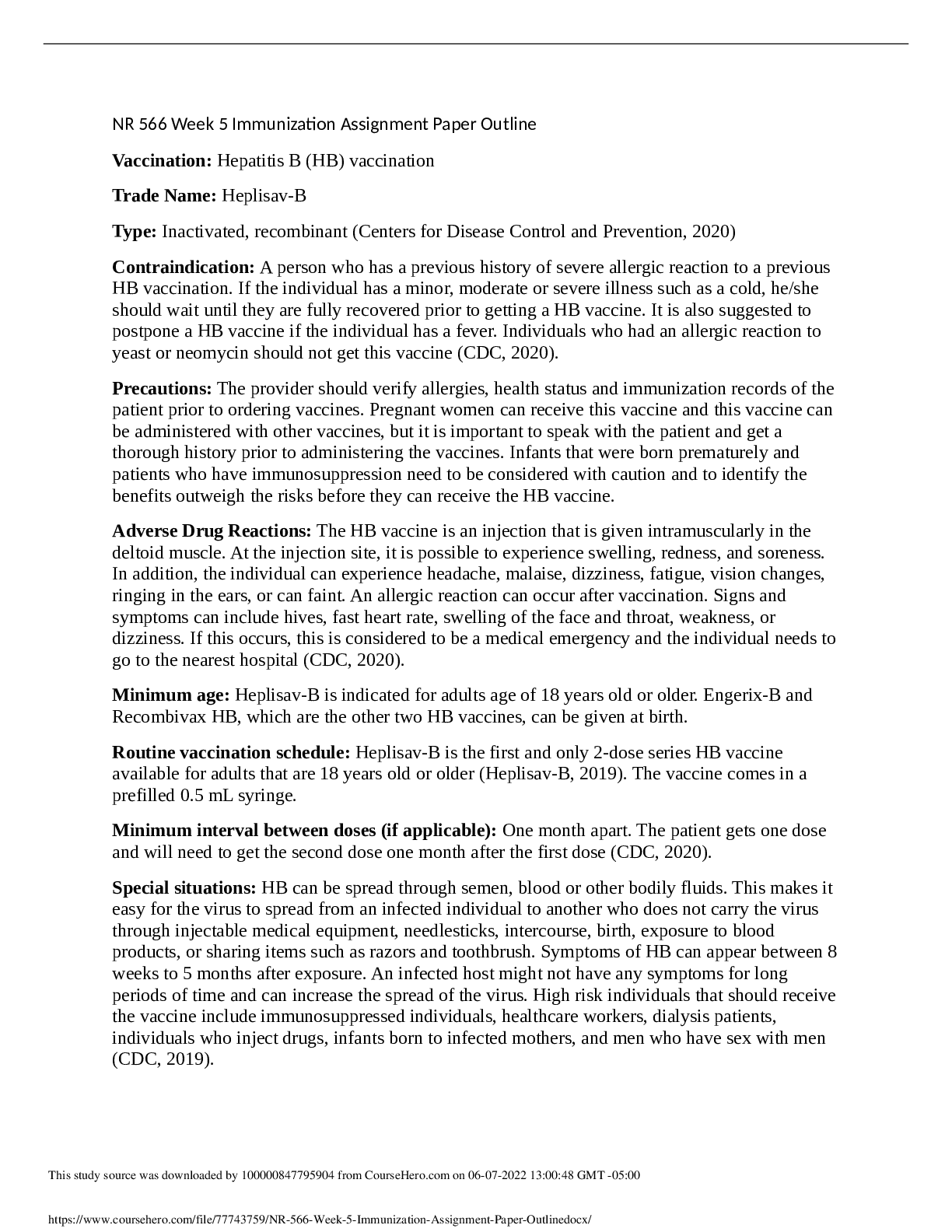
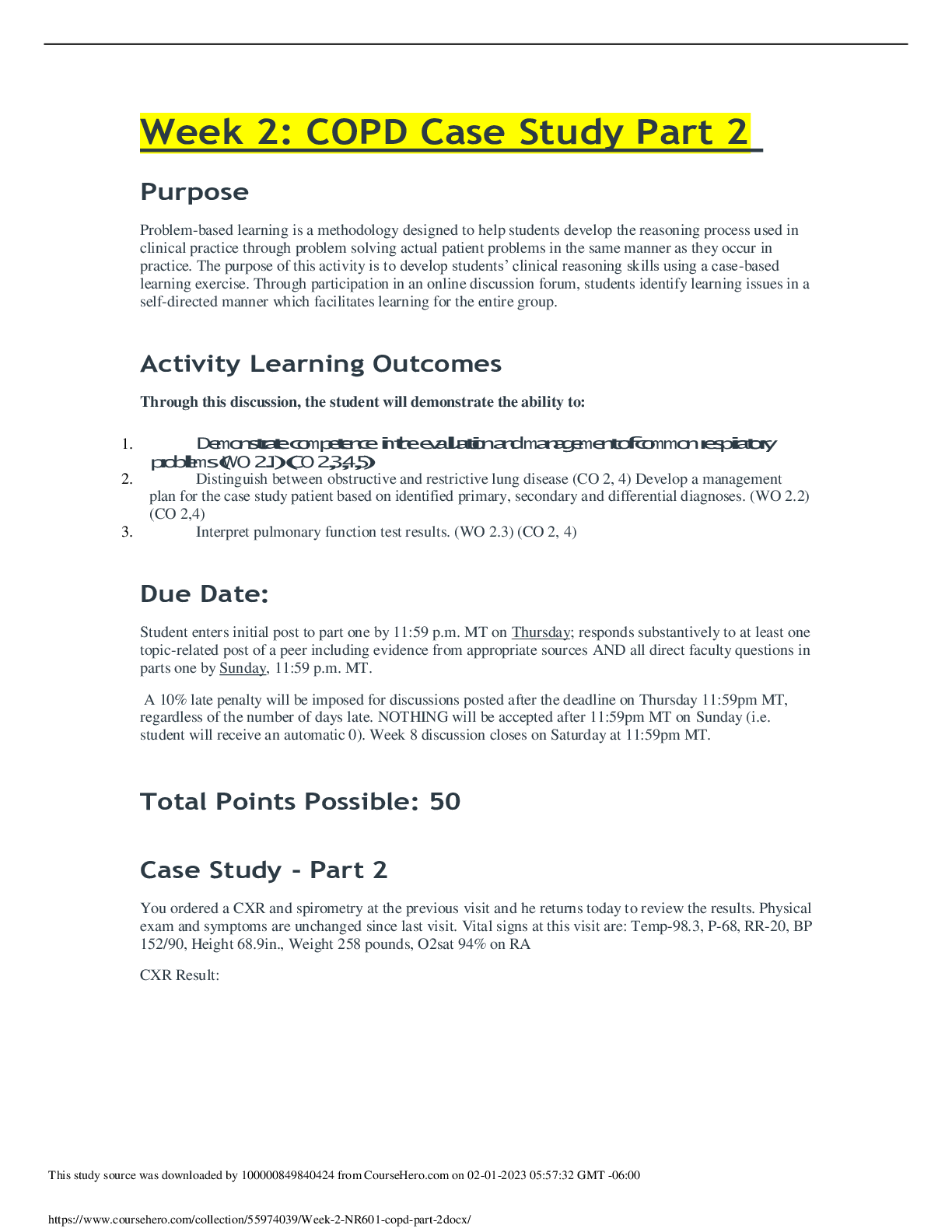
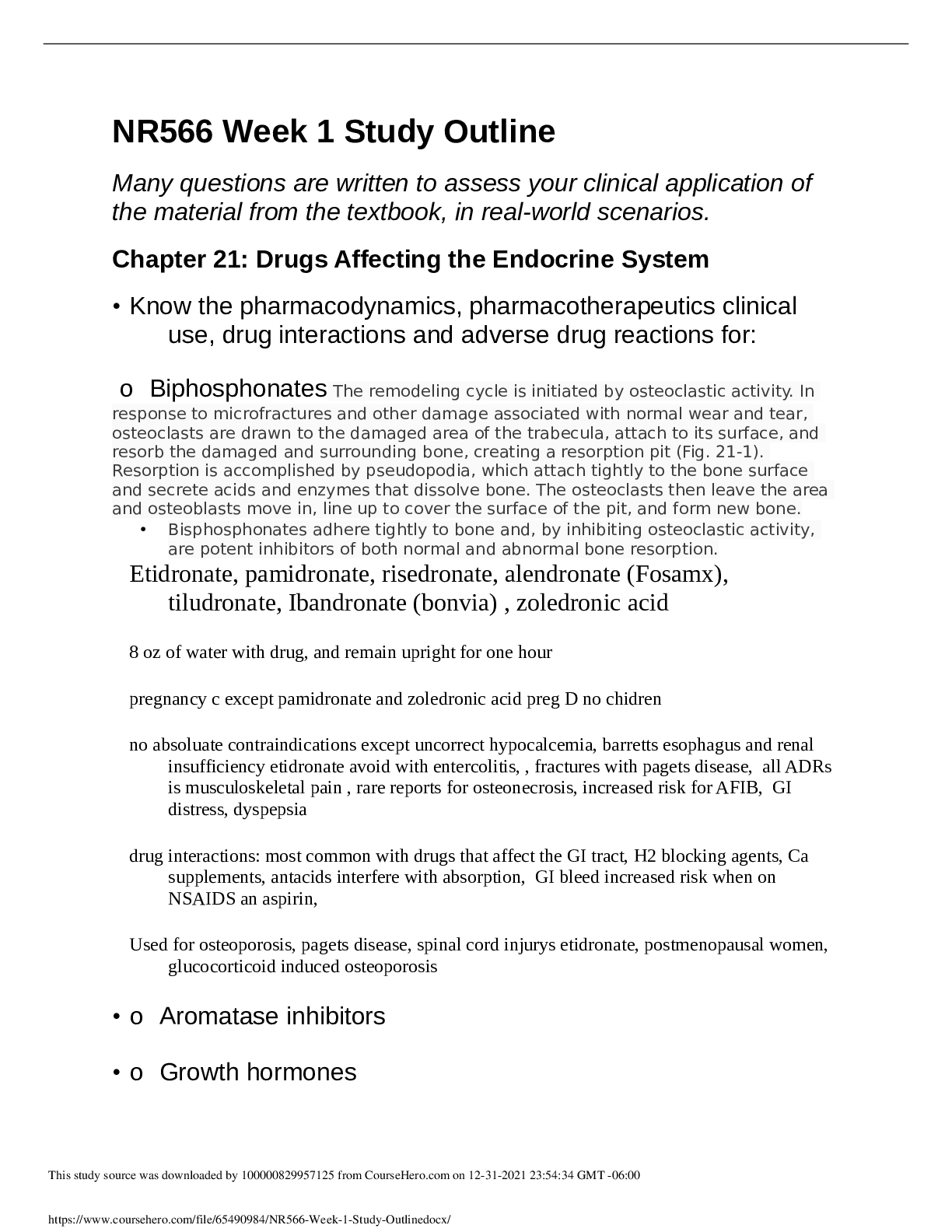

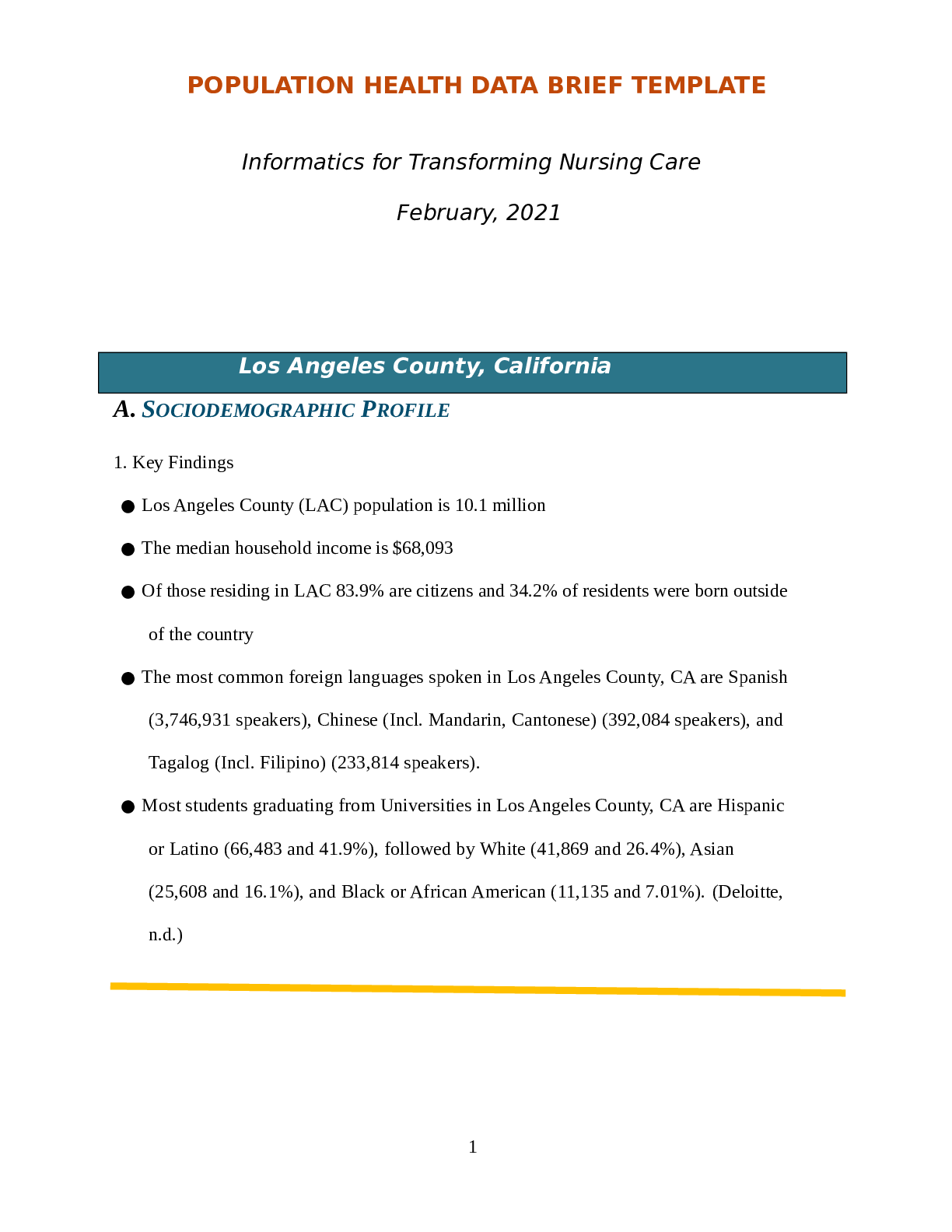

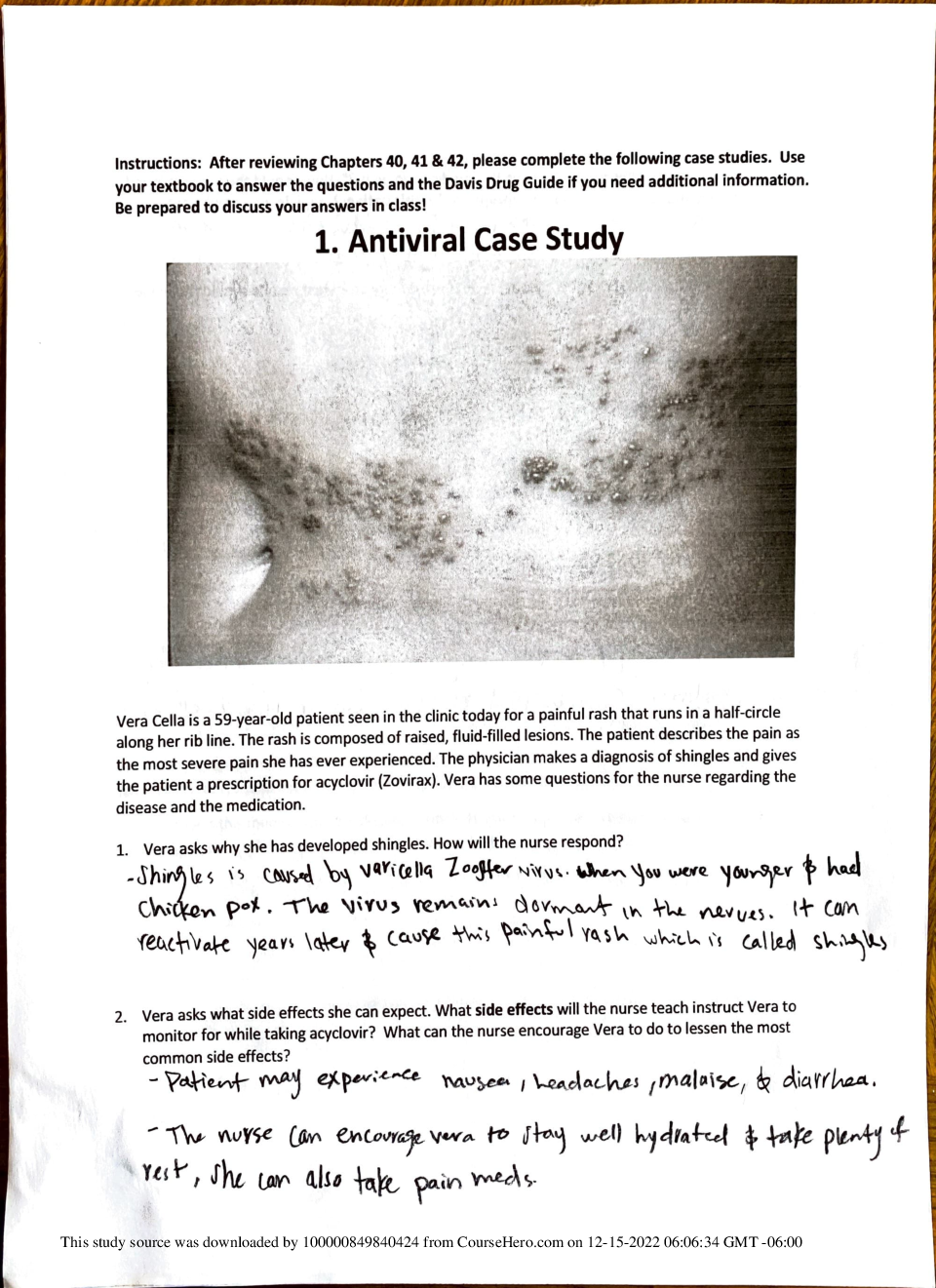


.png)
